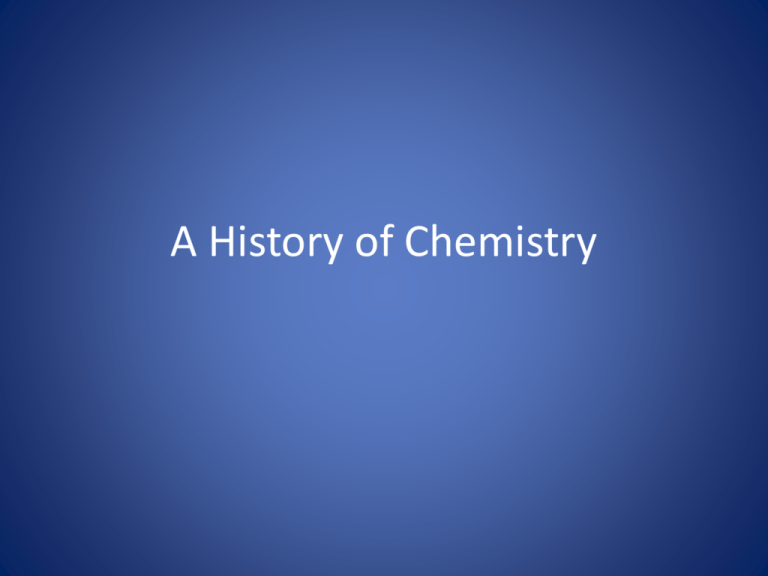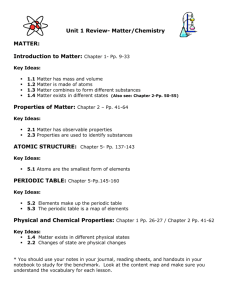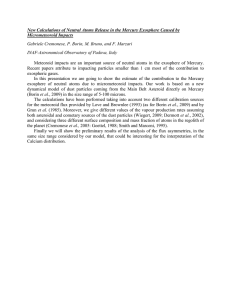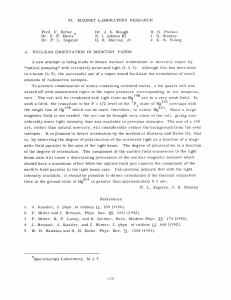chemistry history
advertisement

A History of Chemistry Where did it all begin? • • • • 1000 BC – production of Iron from ore Wine making Primitive alloys Farming (Fertilizer) Early Elements • In 340BC Aristotle proposed that all matter was made of composed of earth, wind, fire and water Alchemy • 1500’s – 1700’s • Trial and error, serendipity • Big claims, little returns (gold, universal solvent) • Discovered distillation and recrystallization • 14 Basic Elements (didn’t know what elements were) S, Hg, C, Fe, Pb, Cu, Sn, Ag, Au, P, As, Sb, Bi, Zn How would you go about making/purifying an element? Experimental method Jan Baptista van Helmont The ‘Fathers’ of modern chemistry An Element defined • Robert Boyle (English Scientist) in 1661 • Defined an element as: “Certain primitive and simple or perfectly unmingled bodies, which not being made of any other bodies or of another, are the ingredients of which all those mixed bodies are immediately compounded and into which they are ultimately resolved.” • Took until 1900’s to discover most elements. Joseph Priestley • First person to isolate elemental Oxygen • ~ 1780 - 1790 • Achieved by using heat to decompose Mercury (II) Oxide Mercury and Oxygen Antoine Lavoisier • 1780 – 1790 • Observed that Oxygen was the element which was responsible for the increase in mass in combustion reactions… • Developed the Law of Conservation of Mass: During a chemical reaction, the mass of the products will be equal to the mass of the reactants So.. What are the differences between Chemistry and Alchemy? Just Quickly… 1. Gold was used extensively thousands of years ago by the Egyptians. Which properties of Gold are linked to this early use? 2. What is the law of conservation of mass? 3. Apply this law to calculate: The mass of Mercury Oxide which would decompose to produce 2.00g of liquid mercury and 0.16g of oxygen gas. How do elements get their symbols? • First letter, or two letters of their name • First letters of Latin names (Pb = Plumbum) Copper = Cu (From Cyprus) Latin: cuprum • First letter of element in another language: i.e. Tungsten (W): German - Wolfram i.e. Mercury (Hg): Greek - Hygor Argyros meaning liquid silver John Dalton • Derived symbols for elements • In 1805 he proposed that matter was composed of atoms, and backed this up with experimental findings Daltons key ideas • • • • • • • • All matter consists of individual atoms Atoms of a particular element are identical in size, weight and properties Atoms of each element have a unique weight Atoms are neither created or destroyed in reactions (WHAT DO YOU THINK ABOUT THIS?) Compounds are formed from the combinations of the atoms of two or more elements The proportions and kind of elements is fixed in a given compound Atoms combine in simple numerical ratios The most stable compounds of two elements contain the atoms in a one to one ratio. Daltons key ideas contd.. • Gave Hydrogen the relative atomic ‘weight’ of 1 unit, and compared other elements to this HOW WOULD HE DO THIS?? The periodic table • Can you think of some elements with similar properties? • How about different properties? Jons Berzelius • Gave the elements their various symbols • Synthesized many compounds • Isolated and Purified many of the common elements • Calculated accurate relative atomic masses (published this in 1828) Dmitri Mendeleev • From the vast amount of experimental data available from the previous chemists he determined that: “Chemical properties of the elements vary periodically with increasing atomic mass” • In 1869 devised a periodic table by: - Arranging elements with similar properties into columns (groups) - Arranging elements in order of increasing relative atomic mass into rows (periods) The Periodic Table • Mendeleev’s table wasn’t complete but.. • It allowed him to predict properties of undiscovered elements including colour, density and boiling point/melting point • Other contributors to the Periodic Table: John Newlands, Lothar Meyer










